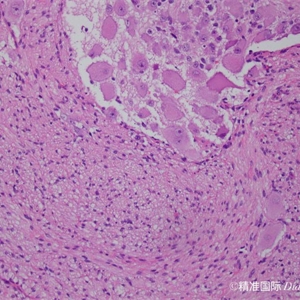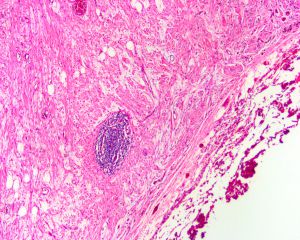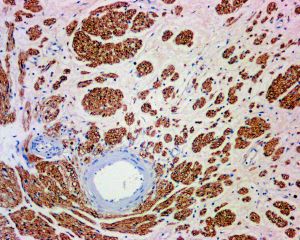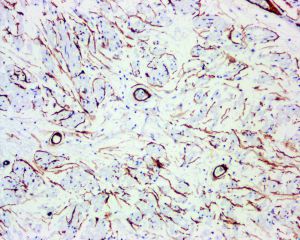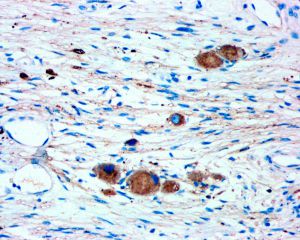节细胞神经瘤
Ganglioneuroma,GN
刘正智 赵明 夏成青
发布时间:2016-07-27 13:17:42
概述:
发病部位:后纵隔、腹膜后、肾上腺、颈部、皮肤、膀胱、前列腺、睾丸旁、卵巢和胃肠道。
诊断要点:
2. 形态上可分为成熟中型(maturing subtype)和成熟型(mature subtype):
3. 成熟中型是指在丰富的施万细胞间质内可见到完全成熟的神经节细胞,伴有少量不成熟神经节细胞和散在分布的分化神经母细胞成分;
4. 成熟型是指施万细胞间质背景中全部是有卫星细胞围绕的完全成熟的神经节细胞成分;
5. 节细胞的胞质丰富,呈淡嗜伊红色,核大,圆形或椭圆形,染色质淡,内含1~3个核仁。
免疫组织化学染色:
鉴别诊断:
1、神经纤维瘤:一些区域与节细胞神经瘤没区别,但是缺少神经节细胞。
2、细胞性神经鞘瘤:好发于腹膜后及后纵隔,缺少神经节细胞;S100弥漫强阳性。
预后:
治疗:
参考文献:
1.Hu J et al: Retroperitoneal composite pheochromocytoma-ganglioneuroma : a case report and review of literature. Diagn Pathol. 8:63, 2013
2.Li J et al: Diagnosis and treatment of 29 cases of adrenal ganglioneuroma. Eur Rev Med Pharmacol Sci. 17(8):1110-3, 2013
3.Li L et al: Acquired primary cutaneous ganglioneuroma with adipocytic metaplasia: "An end point of melanocytic 'maturation'?" a case report and meta-analysis with comparison to a cross-sectional study of neurotized melanocytic nevi. Am J Dermatopathol. 33(1):17-26, 2011
4.Thway K et al: Diffuse ganglioneuromatosis in small intestine associated with neurofibromatosis type 1. Ann Diagn Pathol. 13(1):50-4, 2009
